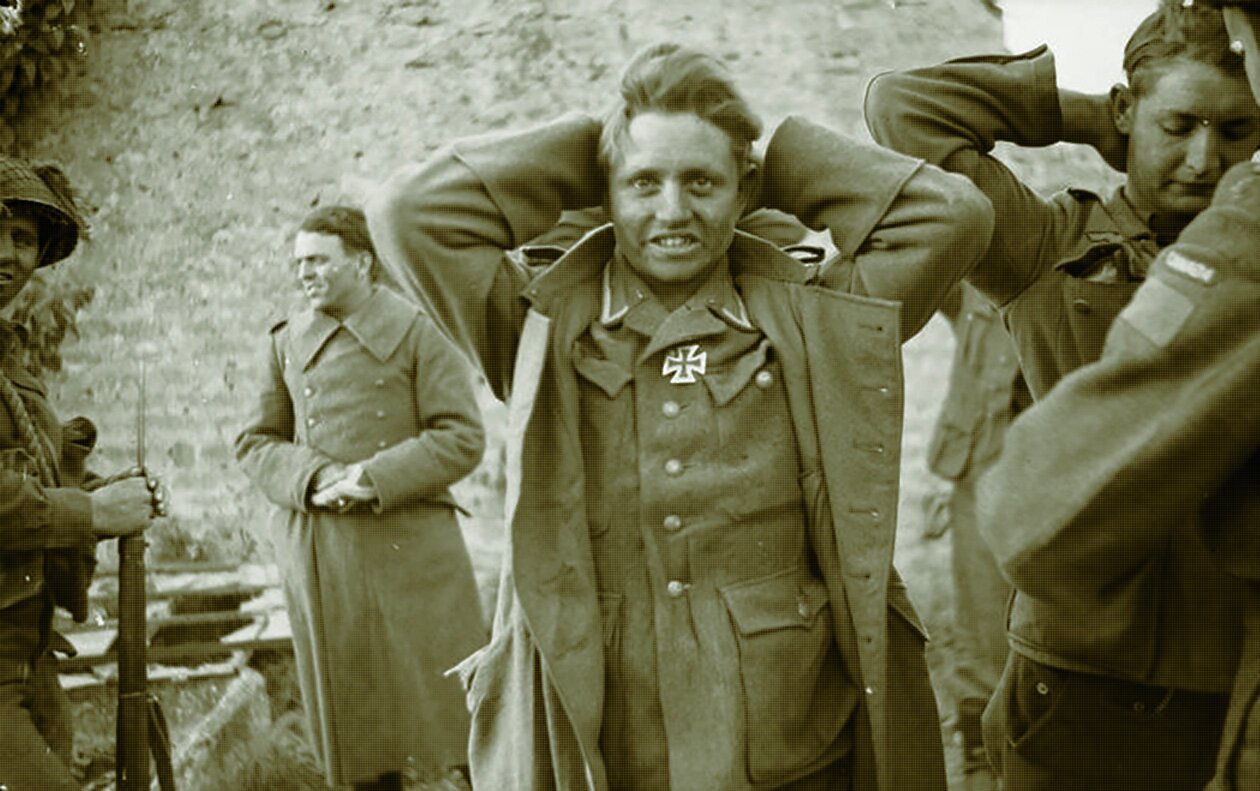By Mark Zuehlke
A wounded Canadian soldier is treated by a medic during the heavy fighting in Normandy, June 1944
With Hartigan popping smoke rounds into the street to cover the running Canadians, Morrison started burning off one Bren magazine after another at the many live targets revealing themselves. Despite the covering smoke, a machine-gun burst stitched across Comeau’s chest and he dropped dead on the cobblestones seconds before Morgan shouted, “Take up positions.”
The sergeant and Chaddock burst through the entrance door of a house as per procedure almost side by side. Then one swept “the first room to the left, the other to the right, where they killed two German soldiers. Then, after exploding a hand grenade on the space above the hall stairway, up they went and cleared the upper floor. They did a rapid search and, within seconds, Morgan led Chaddock to another building, tossing grenades in as chunks of concrete and brick flew everywhere from enemy machine-gun fire. The bullets sprayed nearby as they stepped aside to let their lobbed-in grenades explode. Another standard-drill entry brought them face to face with a big German sergeant. He and Morgan must have fired at the same instant, for the German fell to the floor and Morgan was wounded. He had two Schmeisser rounds in his abdomen.”
Canadian soldiers disarm and search German prisoners near Caen, Normandy during the bitter battles to hold the D-Day beach-heads.
Hartigan and Morrison covered the fighting party’s rapid retreat from the village, with the corporal throwing down a mix of smoke for cover and shrapnel bombs to keep the Germans ducking. The whole raid was concluded in minutes, and then the patrol scrambled back to the crossroads under heavy protective fire laid down by the men in the front lines. When Morgan “came tumbling over a low stone wall, which had marked our jumping off point to begin with,” Hartigan noticed that “he was clasping his bleeding abdomen.” The sergeant gave a terse report to ‘C’ Company’s Lieutenant Sam McGowan and then, rejecting offers of assistance, walked straight to 224 Field Ambulance’s surgery for treatment.
Even as the patrol had scampered out of the southeastern corner of the village, the troops had noticed the Germans were also on the run—pulling back into Bavent’s northwestern quad- rant. A three-man follow-up patrol a couple of hours later, which managed to capture a slightly damaged German mortar on a rise overlooking the village and bombarded the enemy until all the munitions were expended, observed that the troops in Bavent had not yet reoccupied the abandoned area. Nor did they venture out to try and silence the mortar harassing them.
Hartigan noticed how this report substantially bolstered ‘C’ Company’s morale. “They now knew their enemies were, like themselves, subject to human frailty. They [Morgan’s platoon] had done it all, and the enemy though well armed and in good positions, had managed to kill only one of them.... Knowing that they could shake up a much larger body of enemy soldiers boosted their confidence. Even so, everyone was happy to be well out of it and figured it would be some time before they’d have to do something as crack-brained again. Nine men with light but well-organized support from a firm firebase had assaulted a considerably greater enemy force, killed four to six of them and wounded others, and got away with it.”
But ‘C’ Company’s patrolling work for June 7 was not yet over. To the amazement of all the section leaders, they were summoned to the company headquarters in an old house next to the crossroads and briefed by their commander, Major John Hanson, on another daylight mission towards Bavent that would be followed up by a patrol after dark. The sections of Sergeant Dick MacLean and Sergeant M.C. “Mosher” MacPhee would carry out both operations, while Morgan’s section, now led by Hartigan, would be responsible for ‘C’ Company’s defensive positions at the crossroads. The daylight task entailed escorting two Royal Engineers and a couple of British artillery Forward Observation Officers to where the earlier patrol had captured the mortar. From this height, the artillerymen would direct fire by the 302nd Field Battery on enemy targets, while the engineers plotted a route by which the night patrol could enter Bavent from the north. The purpose of this penetration was to plant booby traps and antipersonnel mines around an enemy vehicle park.
The soldiers of the 12 SS Hiltler Jugend Division were mostly fanatical teenage boys.
Canadian casualties steadily mounted during the German counterattacks against the Normandy beach-heads.
When Sergeant Dick MacLean briefed his men on the task, privates H.B. “Sinkor” Swim and Willard Minard looked at each other in consternation—realizing that this patrol and the night one would be using exactly the same route to approach Bavent as Morgan’s fighting patrol had earlier traversed. The two privates muttered to each other that “taking the same route... was certain suicide.” Surely the Germans would twig to how the Canadians were getting into their front yard—much of which followed a tree-shadowed bank of le Prieur irrigation canal.
All they had to do was set up a machine gun at their end of the canal and fire down its length to slaughter the advancing patrol.
Despite thinking the mission the height of lunacy, the fourteen paratroops walked out into the afternoon sun with their four charges in tow. A sharp breeze was blowing as they moved through several apple orchards and then ventured out on the narrow track that bordered the canal. The overhead branches rustled loudly, while the tall grass growing up around the trees shivered as if Germans were crawling around there. MacLean and Swim were on point, one watching forward and left and the other forward and right, while also furtively scanning the overhanging branches for enemy snipers. Finally, they reached a canal crossing, slipped over it, gained the rise, and hunkered down while the engineers discussed viable approaches for the night mission and the two artillery officers looked down upon an amazing target.
In a meadow beside Bavent, a large group of German soldiers had dug a series of slit trenches to form a fighting position and were now lying around on the grass enjoying the breeze and warm sunshine. One of the artillerymen spoke into the handset of the No. 18 wireless he carried. Soon a shell exploded to the east of the Germans. The FOO radioed a correction that brought a shell down this time west of the enemy. Both having landed well away from their position, neither round alerted the Germans to the closing threat, which struck a few minutes later when the artillery battery dropped a full concentration directly onto them. Although Swim knew the men below were the enemy, he found it “agonizing to watch their awful fate.” When the smoke cleared “dead bodies [lay] everywhere as the living squirmed along the ground, trying to reach their slit trenches.”
By 1530 hours, the patrol had returned unscathed to le Mesnil crossroads and the men were told to bed down in Hanson’s house to get some rest before going out on the night patrol. It was the first sleep any of the men had managed since a dawn reveille on June 5 at Harwell Field in England. Yet the majority of the soldiers, including Swim, found rest elusive. After the early morning raid on Bavent and the shelling of the soldiers—obviously brought down on them by someone direct- ing fire from nearby—the Germans would surely be lying in wait.
Canadian soldiers treat a young wounded French boy who was caught up in the shelling of a village in Normandy, June 1944





